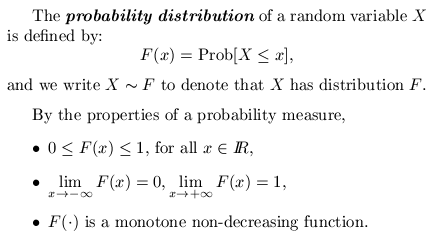
by Felisa J. Vázquez-Abad and Yanick Champoux
Generation of Random Variables
|
Basic Notions
Cross Referencing: |
The Inverse Function Method


Prob[X(U) < x] = P[F-1(U) < x] = P[U < F(x)] = F(x), where we have used the property that a uniform (0,1) random variate has probability h of being in a subinterval of (0,1) of size h. It then follows that the method indeed generates a random variable with the desired distribution.In the discrete case, we have (see diagram above): Prob[X(U) = k] = P[F(k-1) k where F(0)=0.Extreme ValuesHere is a non-trivial example of how the Inverse Function Method can be used to decrease the computational effort in generating extreme values. The example is taken from Law and Kelton (reference***).
Let
{Yk, 1 < k < n} be independent and identically distributed random
variables and suppose that the simulation requires generating the extreme
values
Continuous Random VariablesThe Exponential, Pareto, Weibull and other continuous random variables with easily invertible distribution functions are straightforward to generate with this method, since we can evaluate the inverse function F-1 analytically. But other distributions may require numerical methods to invert the distribution, as is the case for distributions belonging to the Gamma family. In these cases we use other methods that may result in faster and more efficient generators. Discrete Random VariablesThe Geometric distribution can also be easily and efficiently generated. Actually, for a discrete random variable we can always write a generic program to use this method, but it may not always be the most efficient generator. |
| Methods | Distributions |
© Copyright 1998 Felisa J. Vázquez-Abad and Yanick Champoux. All rights reserved.
